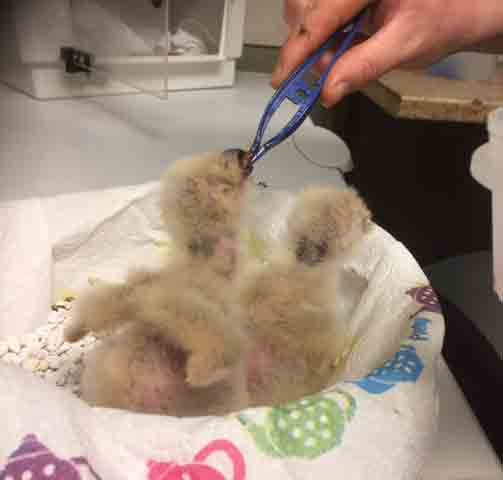Throughout the owl sanctuary breeding season the falconers’ hut at S.O.S. bears more resemblance to a raptor creche than the centre of falconry operations! This is because alongside our wild bird rescue activities, many of the captive bred birds we keep at the Sanctuary used for the flying demonstrations we give to fulfil our educational brief are hatching eggs left, right & centre!
Those of the young offspring which our falconers select to use for these demonstrations in future are hand reared so that they become accustomed to - and comfortable with - interaction with humans. The others are reared separately and often exchanged with other centres similar to our own to inject fresh bloodlines into the system.
For training to progress satisfactorily, baby birds chosen to form part of the flying team must recognise the falconers as their food source from the time that they hatch from the egg. All the activities that can be witnessed at the sanctuary which involve the owls and other birds of prey working with the falconers are established through this demand for and supply of food.
The young birds are weighed every morning to ensure that they are keen enough to look to the falconer to be fed whilst retaining optimum condition. The foundations for this relationship, needs to be established as a priority, as soon as possible.
Therefore, after eggs hatch in the incubators, they are moved to a brooder in which the temperature can be precisely controlled and the tiny chicks closely monitored. At this time falconers assume the role of Mum by feeding the pulli often and regularly, with tweezers resembling the parent bird’s beak.
Owls and other birds of prey grow extremely quickly due to their high protein diet and within weeks, the young are out of the brooders and strutting confidently around the “creche”.
Those birds that move on to new homes at other conservation projects or falconry centres will leave at about 8 - 10 weeks, whilst those that are to remain at the sanctuary can co-habit with the falconers for several more weeks, right up to the advent of serious training, when a permanent home is found for them in the aviaries.
It is not only the sanctuary’s own hand reared babies which share the falconers’ accommodation - any baby birds arriving at the sanctuary from other conservation centres to contribute to the educational remit of the centre will also spend their first few weeks getting to know their contemporaries and the staff who care for them within the protective environment of the staff quarters.
This year baby raven, Charles has joined the sanctuary’s avian community along with new Mackinders Owl, Nakura. Both have settled effortlessly into their new home and staff hope that on maturity they may form permanent pair bonds with established residents Rey and Kalifi respectively.
A pair of African Spotted Eagle Owl chicks are hand fed and then enjoy a dozy nap...
Baby raven Charles enjoys a nap after a feed, too...
Nakura, our baby Mackinders Owl gets bigger by the day!





